The Mighty Quinn - how the TOP Program for interns changed my life
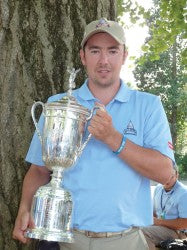 "Basically, I took a sense of ownership, pride and responsibility for my section. And, once you do that, the long hours don't matter and the time starts to fly by"
"Basically, I took a sense of ownership, pride and responsibility for my section. And, once you do that, the long hours don't matter and the time starts to fly by"
I never knew why they called it the TOP Program when I first heard about the internship programme run by Irishman Mike O'Keeffe, at The Ohio State University, but now I do. No other programme could do what they have done for me during the last eighteen months, and I will prove it to you if you read the rest of this article.
My name is Daniel Quinn and I am from Milton Keynes. I began my career at Woburn Golf Club, when I was sixteen, as an apprentice. After studying at Oaklands College, and working at Woburn for eight years, I discussed my next career move with my Course Manager, John Clarke, and he mentioned The Ohio Program and what it had done for his confidence and career.
John put me in touch with Mike O'Keeffe, who has managed the turf programme for the last twenty-five years. Mike has access to an amazing network of courses around America, and the world for that matter. Because he knows everyone in the golf industry in the British Isles, he knew exactly what I was capable of and how to challenge me to take me to the next level - as he has done for hundreds of other young greenkeepers who are out there and successful now.
 Once all the paperwork and visa application was complete, I found out I would begin my internship in Virginia, at The Robert Trent Jones Golf Club (RTJ). You may remember reading some previous articles from David McGregor in Pitchcare about this great course. David also inspired me to do this programme based on those articles and, hopefully, here I can inspire someone else.
Once all the paperwork and visa application was complete, I found out I would begin my internship in Virginia, at The Robert Trent Jones Golf Club (RTJ). You may remember reading some previous articles from David McGregor in Pitchcare about this great course. David also inspired me to do this programme based on those articles and, hopefully, here I can inspire someone else.
What you have to realise is that Mike and his staff have done this hundreds of times before. Be careful of programmes who have not, as they are out there.
Mike seeks out courses that put together the best deal for his interns. He works with RTJ because they invest a lot of money to recruit the best interns every year. They provided a rent free, fully furnished apartment, and transportation to work every day. This made me feel at ease and it definitely helped me to make the move across the pond to America and not feel like I had lots to organise before I started.
 Scott Furlong is the Superintendent there, and David McGregor was the assistant [David has since moved onto a Superintendent's position]. They pay excellent wages, and time and a half for overtime, which there is lots of, as you will find out.
Scott Furlong is the Superintendent there, and David McGregor was the assistant [David has since moved onto a Superintendent's position]. They pay excellent wages, and time and a half for overtime, which there is lots of, as you will find out.
I arrived in the States at the end of March 2011 but, before I went to Virginia, I spent the first couple of days in Columbus, Ohio, on orientation. I met the staff who run the programme and saw, first-hand, the processes that make it so successful. I was given a tour of The Ohio State University campus and was made to feel very welcome from the start.
The organisation and the amount of effort the staff put in to the programme's success is evident as soon as you meet them. Every one was friendly and willing to go the extra mile to ensure that the new arrivals were ready and prepared for their placements. After my orientation, I knew these people wanted me to succeed, and I knew each one of them would be there for me if I needed anything. This was a great way to start in America.
 Next, it was on to Virginia via the east coast to begin my placement at RTJ, a course set on the edge of Lake Manassas. This is a course that has hosted no less than four Presidents Cups, the most recent in 2005.
Next, it was on to Virginia via the east coast to begin my placement at RTJ, a course set on the edge of Lake Manassas. This is a course that has hosted no less than four Presidents Cups, the most recent in 2005.
During my time there I was challenged to my limits, working long hours and experiencing the high expectations that a course of that stature requires, with every inch manicured to perfection.
I experienced everything during the summer in Virginia, weather wise. We had frosts when I first arrived, tornado warnings just before the summer started, and days that reached 120OF (48OC) on the heat index in July. I even got to experience Hurricane Irene at the end of August, whilst the earthquake that hit Washington DC was close enough that it made my cart shake at work!
It was very tough getting used to working in high humidity and doing long hours. I could see it being a long summer but, after a few weeks, it became the norm, doing everything from cutting cups and rolling greens to spray-hawking greens or spraying fairways in the morning and then either looking after greens, checking for wilt or doing irrigation work in the afternoon.
 The summer months were brutal in Virginia, with July being the hottest on record! This meant one thing; long hours! Most days we would complete morning setup, which was normally mowing greens and rolling, and then grab hoses and go into our sections and hand-water for the rest of the day, Myself and one other intern looked after holes 6-12 and, most days, it was left to just one of us to look after the greens so, from 10.00am to 6.00pm, we would be syringing seven greens every hour or so. The only time we would get a break was when the sun started to go down and the shade started to cover the greens.
The summer months were brutal in Virginia, with July being the hottest on record! This meant one thing; long hours! Most days we would complete morning setup, which was normally mowing greens and rolling, and then grab hoses and go into our sections and hand-water for the rest of the day, Myself and one other intern looked after holes 6-12 and, most days, it was left to just one of us to look after the greens so, from 10.00am to 6.00pm, we would be syringing seven greens every hour or so. The only time we would get a break was when the sun started to go down and the shade started to cover the greens.
It was a real challenge to begin with, but one I started to enjoy and get used to as I learned how to read my greens, know what to expect, know where the hot spots were. I learned how to watch the humidity levels and how my greens would react as a result. Basically, I took a sense of ownership, pride and responsibility for my section. And, once you do that, the long hours don't matter and the time starts to fly by.
At the end of the summer, the club began work on a new 6-acre short-game facility. Watching a design being created from scratch was amazing. Contractors came in and completed most of the work, which included building three USGA spec greens and sculpting four practice bunkers, plus irrigation for the whole area. Once they had completed their work, it was time for us to seed and prep the area for the growing in stage.
We sodded all the rough areas with rough bluegrass and then seeded the fairways and greens areas with A1/A4 bentgrass. The four bunkers all had different drainage techniques. We put asphalt in one, just levelling it off leaving it porous; we used a sportcrete in another and sprayed it with isocyanate; and then a gravel layer under the isocyanate in another; and just a normal shingle drainage setup in the last. This was to compare the drainage types to see which one was best to use so that, in the future, bunkers on the course could be improved. This was a great learning experience for me.
 One of the highlights was when I was selected to spend the day working at the White House where I got to work on the President's putting green. It was a surreal moment in my career and an amazing memory; one I will never forget. Unfortunately, the President was not around, just lots of security! After we finished our maintenance of the green, we got a quick tour of the White House and got to take some pictures standing on the back lawn.
One of the highlights was when I was selected to spend the day working at the White House where I got to work on the President's putting green. It was a surreal moment in my career and an amazing memory; one I will never forget. Unfortunately, the President was not around, just lots of security! After we finished our maintenance of the green, we got a quick tour of the White House and got to take some pictures standing on the back lawn.
In June, I was fortunate enough to be selected as one of the volunteers for the 111th US Open at Congressional in Bethesda, Maryland.
I had worked several tour events during my time at Woburn Golf Club, but this was on a completely different scale. I arrived for orientation on the Sunday and there were about 120 volunteers there. The organisation was excellent and the whole week was fantastic! I mowed fairways in the mornings and touched up bunkers from the day's play in the evening.
 Being part of a major tournament was amazing and, to be able to see an operation of that size being run, was an eye opener to say the least. You could see the way that the team at Congressional and the USGA were working together to achieve the best results, The tournament was a great success, and I even got to hold the US Open trophy! The whole week was definitely a highlight of my career so far and was great to be part of.
Being part of a major tournament was amazing and, to be able to see an operation of that size being run, was an eye opener to say the least. You could see the way that the team at Congressional and the USGA were working together to achieve the best results, The tournament was a great success, and I even got to hold the US Open trophy! The whole week was definitely a highlight of my career so far and was great to be part of.
I worked at Robert Trent Jones Golf Club until December, and I am really grateful that Mike O'Keeffe placed me there. Mike knew exactly how to challenge me to bring out the best in me. I will never forget the staff at RTJ, especially David McGregor and Scott Furlong, for giving me some great and constructive criticism, showing that they really cared about my success and future.
After working at RTJ, I moved to the Ohio State University campus for the winter quarter (January to March). The university is almost a city on its own. They have two Alister MacKenzie designed golf courses on campus, 63,000 students and a stadium that holds 106,000 people for their football games. The place is amazing.
I took five classes and also two of the world famous professor, Dr Karl Danneberger's, online courses. He has created two fantastic online courses that I would highly recommend to anyone. The first is in Golf Course Management, covering warm season and cool season grasses, and the second is in Turf Stress Physiology; both courses were very in depth, but are really enjoyable and will definitely help you to improve your knowledge in the golf maintenance industry.
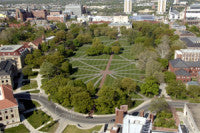 Studying at OSU was fantastic and a great experience - except for the freezing weather and snow! Everyone was really friendly and helped out where possible. My class schedule was really good and it gave me time to really enjoy the student life.
Studying at OSU was fantastic and a great experience - except for the freezing weather and snow! Everyone was really friendly and helped out where possible. My class schedule was really good and it gave me time to really enjoy the student life.
On top of the great turf classes, I also got to take a class in the PGA/PGM department in business planning, studying business plans and ways to improve management practices.
OSU offer a five year degree in this area of Professional Golf Management, and it was informative to see the other side of a golf club's business and management.
The business class was really enjoyable and I had to create my own business plan from scratch, assessing a golf course's assets and identifying ways to improve the business, setting goals, predicting financial forecasts and setting up budgets.
I took classes in golf course management, plant pathology and disease management and turfgrass management and science, all of which helped me to improve my knowledge, and made me look at a golf course totally different now, identifying problems faster, recognising potential issues, whilst helping me with ideas to improve the course and ways to improve myself.
Whilst on the programme, I signed up for The Turf Club, a group of turf students who raise money to pay expenses to attend the GCSAA/GIS industry show. This was held in Las Vegas, and it was great to see all the latest and greatest technology and ideas for the future on display, and to do some networking and meet the people behind all the technology.
As I was a student at OSU at the time, I also got to take part in the annual collegiate turf bowl competition, which is a team event that lasts four hours, testing our knowledge in every subject of course management. An experience that I will never forget!
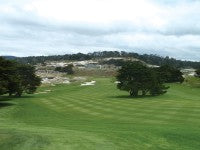 I should mention that you cannot just attend OSU classes, you have to be selected. This is based on your previous education in turf and your performance in your first internship. The cost of the classes is not cheap but, as you can see from my experience, it's worth every penny. I saved enough money whilst at RTJ to cover all my expenses at OSU.
I should mention that you cannot just attend OSU classes, you have to be selected. This is based on your previous education in turf and your performance in your first internship. The cost of the classes is not cheap but, as you can see from my experience, it's worth every penny. I saved enough money whilst at RTJ to cover all my expenses at OSU.
On return from Las Vegas, I had a couple of weeks left at OSU, I completed my final few classes, took my final exams and then headed for my second placement.
Again, this was designed and organised by Mike O'Keeffe. He takes so many factors into consideration, and knows so much about you at this stage, but remember, he's putting his name and the programme's reputation on the line every time he sends someone out to a course. This would not be such a big deal if he was sending you to a regular golf course. The problem is, Mike only deals with the best courses in the country and, to be honest, I had no idea what I was getting into when I immediately agreed to his next choice of placement - Cypress Point Club in Pebble Beach, California. Mike has only sent one other intern to Cypress Point Club, so I knew that I was very lucky to be placed there and that this place was special. I had tried to find out more about the club online but, because it is really exclusive, there wasn't too much to find out.
Cypress Point Club is ranked number two in the world and is one of the greatest and most prestigious courses anywhere on the planet. It is situated in northern California on the Monterey Peninsula, surrounded by other great courses like Pebble Beach and Spyglass Hill. It was designed by Alister MacKenzie in 1928, and its history and tradition can still be seen today as the course is very traditional and kept looking like a course from the 1950s.
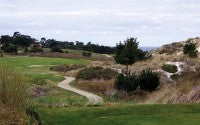 The entire course is manicured to tournament standard everyday, but done in such a way that it doesn't lose that feeling that you are somewhere very special. As soon as you arrive at Cypress Point you realise that you have arrived at a truly historical place.
The entire course is manicured to tournament standard everyday, but done in such a way that it doesn't lose that feeling that you are somewhere very special. As soon as you arrive at Cypress Point you realise that you have arrived at a truly historical place.
I started working at Cypress Point Club in March and was welcomed by Jeff Markow (CGCS Superintendent at CPC) and his entire crew, which included two assistant superintendents and around twenty crew members. I could see straight away that every single one of them was vital to the setup at CPC.
Jeff Markow has been the superintendent for twenty years and has really made the course what it is today. The routines and procedures in place work perfectly, with almost all the crew able to do every job required to keep the standards high. To begin with I was the only intern, so Jeff told me that I would mainly be spraying, but would also help with construction projects from time to time.
I loved working at CPC from the start. Compared to the east coast, the workload was a lot less and the atmosphere more relaxed as the stresses of day to day work was less, even though the expectation levels are still extremely high.
 With the Northern California climate, there was no need to be working long hours and, with most days not getting above 70OF (21OC), it almost had an English summer feeling, the only difference being that, when we reached May, it stopped raining and wouldn't rain again until at least mid-October!
With the Northern California climate, there was no need to be working long hours and, with most days not getting above 70OF (21OC), it almost had an English summer feeling, the only difference being that, when we reached May, it stopped raining and wouldn't rain again until at least mid-October!
Cypress Point Club is currently re-installing 'original design' bunkers, using old pictures from the 1930s to recreate the shapes. It was great to see what the course used to look like back then and, as this was something I had never seen done before, was great to be involved in.
CPC has set routines for most jobs. For example, when mowing greens, they have five sections, with one guy each, taking care of four greens, whilst they share the two chipping greens and two nursery greens on a rota. Each section is responsible for mowing their greens, raking their bunkers, repairing pitch marks and blowing.
The fairways, tees and approaches are mown three times a week, and cups are changed five times a week.
The machinery used is mainly Toro, the small rough mowers are John Deere and then some of the specialist equipment is Smithco/Jacobsen. The maintenance shop is fantastic, each crew member has their own cart and all the equipment is well looked after.
The course itself has some spectacular views and very difficult holes, most notably the finishing holes, where 15 and 16 challenge you to hit over the pacific ocean! Hole 15 plays 135 yards from the championship tees - which out here are called tips - but is very hard as the winds can be very strong off the ocean. Hole 16 is by far the hardest I have ever played. It plays 233 yards off the tip, but the carry alone is 215 yards at least, depending on wind direction!
 And then you come to hole 17, a par 4 along the pacific ocean with several cypress trees in the middle of the fairway, right in the landing area. A fantastic hole and one of the best views in golf. On a clear day you can see right down the coastline to Big Sur; it is truly beautiful.
And then you come to hole 17, a par 4 along the pacific ocean with several cypress trees in the middle of the fairway, right in the landing area. A fantastic hole and one of the best views in golf. On a clear day you can see right down the coastline to Big Sur; it is truly beautiful.
I am really fortunate to have interned at Cypress Point Club and will look forward to returning in the future. I have trained here under Jeff Markow now for seven months, and enjoyed every minute; this is truly a special place.
In June, again through advice and contacts from Mike O'Keeffe, I was lucky enough work as a volunteer at my second US Open, the 112th, at The Olympic Club in San Francisco. I was really looking forward to this as I had worked the US Open the previous year, and it was going to be useful to make the comparison on course setup and organisation for the east coast climate and conditions versus the west coast.
I arrived on the Sunday before the event week for orientation and met Pat Finlen, Director of Golf Maintenance Operations at the Olympic Club, and his entire crew, along with the other 100 or so volunteers from all over the world.
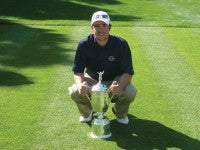 The Olympic Club is a fantastic course and was in great shape. The course looks out over the whole of San Francisco and you can even see the Golden Gate Bridge from the first fairway.
The Olympic Club is a fantastic course and was in great shape. The course looks out over the whole of San Francisco and you can even see the Golden Gate Bridge from the first fairway.
My jobs for the week were to rake the front nine bunkers in the morning and to hand water fairways in the evening behind the day's play. The course played firm and fast and we were told, most evenings, to just keep things alive to try to maintain firmness.
The whole week was awesome, and I met some great people from all over the world who will remain contacts for the rest of my career.
I worked two US Opens during my time on The Ohio Program and would definitely recommend anyone else to volunteer for a US Open in the future, as the networking and friends you make will stick with you for the rest of your life. The whole experience is great to be part of.
I would like to thank the Ohio State University for making it possible, but remember, you are representing not only the programme, but your home club, your country, your college and Mike. He will not recommend you if, for a minute, he thinks that you might let anyone down.
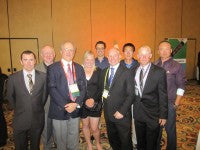 I will be returning to England shortly as I will soon finish working at Cypress Point Club. The memories and experiences I have had during my eighteen months in America will stick with me forever. I have had a truly amazing time and would like to thank Mike O'Keeffe and his team for all his hard work and support during my stay. They really do a top job and make sure that, through the placements, interns will enjoy and learn as much as possible. Maybe now you can see why they call this a TOP Program.
I will be returning to England shortly as I will soon finish working at Cypress Point Club. The memories and experiences I have had during my eighteen months in America will stick with me forever. I have had a truly amazing time and would like to thank Mike O'Keeffe and his team for all his hard work and support during my stay. They really do a top job and make sure that, through the placements, interns will enjoy and learn as much as possible. Maybe now you can see why they call this a TOP Program.
If you are considering doing a programme like this, go with the one that has been around the longest; you can see that none of this happened by chance. TOP plans everything. They have the connections after years of doing this, they know what works. They look out for your best interests. They make sure you get paid the best wages, and get placed on the best courses, with the best Superintendents.
Why waste your time coming all the way over here to mediocre courses that look at you as cheap labour and pay you a stipend. There are loads of those courses over here and you will go back broke!
I would like to thank my family for supporting me during my adventure, and all of the people who have helped me along the way, especially John Clarke and Woburn Golf Club for investing in my future, I couldn't have done it without you.
And finally, I also want to mention that The Ohio Programme helped me get a scholarship from Syngenta, which helped pay for all my classes. They are just one of a number of companies willing to sponsor good students who show promise.
If any of you are considering going on the OSU Programme, and would like to ask me any questions, feel free to contact me at d.quinn569@sky.com and I will be glad to answer them.
Mike O'Keeffe may be contacted via email at okeeffe.1@osu.edu
